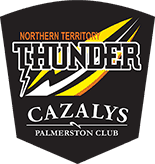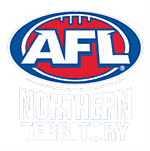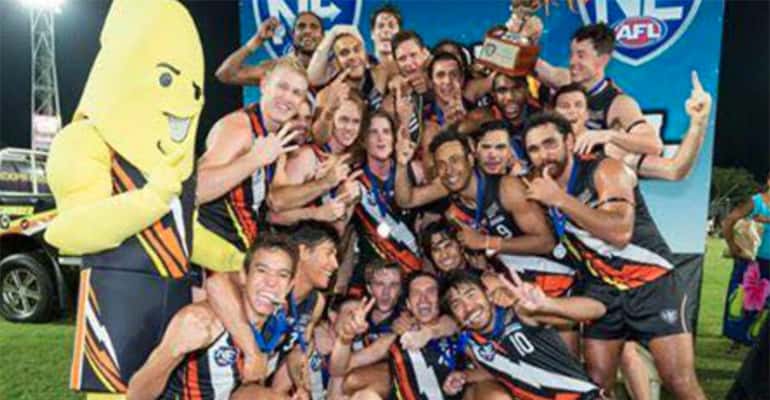by Murray Silby
During a 2013 visit to Elcho Island AFL legend Kevin Sheedy, then coach of the Greater Western Sydney Giants, told the ABC why he’d been a die-hard fan of Northern Territory football and its footballers for so many years.
“It’s flair. It’s Hollywood,” he said. “I think that’s what we like about the Indigenous players and we never want them to change that. They take little risks inside packs; their hands are gifted. I think they’re very exciting players.
“I think the boys, they’ve got speed. You just don’t know what we’re missing out on in the country when you see the speed of some of these boys that have never been trained to be athletes, let alone the skills of Aussie Rules.”
In those short comments Sheedy touched on some of the characteristics that make Territory footy so great – the flair, the speed, the risk taking, the excitement – but also the challenges that make it so difficult for homegrown players to reach the highest level – the Hollywood, the risk taking and the fact most of the Territory is not only country, but remote country and how difficult it is to provide specialist training in so many far-flung regions.
Since 2009 though, the NT Thunder program has been in place to help promising footballers pursue their dreams of making the top without having to leave their homes.
The NEAFL side is like no other in the competition that comprises clubs below AFL level in Queensland, New South Wales, the ACT and the NT.
“I’m the head coach of a NEAFL side, but I also see myself as a development coach where I want to teach these guys to be the best they can on and off the field,” Thunder head coach Andrew Hodges says.
“There is a balance obviously between, any footy club you want to win a premiership,” Hodges adds, “but we’ve got a really good balance between that and development, so we know that the development that we do in the football club, the by-product of that is hopefully a premiership.”
Since Thunder’s inception, eight players have gone on to play or be drafted to AFL level, including Relton Roberts, Shane Thorne, Troy Taylor, Steven May, Jed Anderson, Nakia Cockatoo, Ryan Nyhuis and Willie Rioli.
Then there are the academy successes. Since 2009 there has been seven players drafted who were part of the AFLNT State Academy, but did not play senior Thunder – Curtly Hampton, Anthony Long, Shaun Edwards, Jake Long, Anthony McDonald Tipungwuti, Brandan Parfitt, Anthony Long and Ben Long.
So the results are there, but Thunder officials are determined to bring more through the program, and that’s challenging.
If you take Elcho Island, where Sheedy made his comments back in 2013, as an example, it is 515 kilometres or a one-and-a-half-hour flight east of Darwin, but it might as well be a million miles away from AFL glory on the MCG.
AFLNT High-Performance Manager Wally Gallio says the tyranny of distance and lack of facilities in some communities can hamper efforts to nurture talent, but they are not reasons to give up on it.
“It makes it difficult, but it shouldn’t hinder our opportunities,” he says. “The thing that does hinder it is trying to take someone from Elcho Island and then placing him in an under 16 team and having the ability to see what he’s going to be like in two years’ time and setting his program in place.
“The Darwin and Alice Springs players get that access to the training centres all the time, the gymnasiums and everything like that. It’s taking that raw talent from all over the Territory and building it into a team and getting them and slowly building their structured football and getting them at an early age so by the time they get to their draft year, or they want to get drafted, that everything’s in place.”
The Thunder program helps identify the best young talent in all Territory communities, whether they be suburban or remote, and then put a regime in place to enable them to reach their full potential.
Being able to continue living with family in their own community or town can be a huge benefit to many young players, but it doesn’t make the kilometres that have to be travelled disappear. They still have to be driven or flown – there and back.
“A lot of our guys come in from communities, Lochy Dhurrkay comes in on a flight, then once he gets here to Darwin he’s got to jump on another flight if we’re playing interstate and Abe Ankers in Alice Springs, he travels every week,” Hodges says.
“We’ve only got one game in Alice Springs, there’s one weekend when he gets to stay at home and play, so it’s a massive commitment for him. Matt Green in our state academy, who’s also a rookie-listed player with us, to play a state academy game, he’ll jump on a bus (from Tennant Creek) to Alice Springs for seven or eight hours and then he jumps on a three-hour flight to where we’ve got to play and then he’s got to do that on the way home as well.
“It is a massive commitment, but we provide those opportunities for them to be able to stay at home to study, work and be with family, but also to showcase their talent.”
Education, training and employment are key planks in the Thunder equation, especially at senior level.
In 2017 alone, four senior Thunder players, in addition to those already employed, have been placed in employment, three senior Thunder/U18 (rookie listed) players have been placed in employment and two others provided with school support or engagement.
Three of the Thunder Under 18 players have successfully moved into employment, and two have been provided with school support or engagement.
Founding CEO and current Chief Operating Officer for AFLNT Stuart Totham says in an age when AFL clubs are just as interested in your off-field capabilities as your on-filed strengths, the off-field and academy components are vital parts of the program.
He says though that Thunder is also a football club aiming for premiership glory and in the NEAFL it’s probably found its rightful home instead of going to the SANFL as some had argued it should.
“At that time when it was decided to go to Queensland there was obviously a lot of debate, and I was actually CEO of a SANFL club at the time, and unfortunately, I think there are a couple of things, I don’t think the SANFL at the time had the appetite for it, but secondly, if we did have a team in the SANFL it really would change the structure of footy (in the NT) even more so,” Totham says.
“I think the NEAFL’s a really good level for us; it’s hard enough for us. We can win it, if we’re good enough, but we’re competitive, we’re not thrown to the wolves so to speak.
“If you look at some of the teams our lads get to play against, this year they (AFL teams), they had full squads, Brisbane and Sydney, so 20, 22 listed players, so that’s a fantastic opportunity for our lads to play against AFL-listed players.”
There have been other challenges for Thunder to contend with too that few clubs if any, would ever be required to overcome.
Parochialism was one. Back in 2009, it was a challenge to convince Central Australian fans that NT Thunder was their club as much as it was Top Enders’.
Totham admits it’s something the club is continually working on.
“We had some really good funding at the time through the Australian Sports Commission, which allowed us to play four games down there (Alice Springs). We worked really hard down there, and I think we had some really good results early, but I don’t think there’s any doubt that that’s slipped away a little bit and I’ve only just been back employed in footy in the Territory for the last six months, but there’s certainly a push back to really engage and really make it a Territory team again and I think Andrew Hodges being coach is pushing that as well,” he said.
“If you look at our squad this year, they’re all basically from the Territory, all from different regions, so I think that push is back on, which I think is fantastic because it gives Thunder the uniqueness that it needs to survive. We just need to make sure that we’re giving all those kids opportunities.”
Another constant issue for Thunder management to deal with is that it plays during the southern winter or northern dry season and the local Northern Territory Football League plays during the southern summer or northern wet season.
Meaning players line up with their NTFL clubs during the wet season and then during the dry with Thunder in the NEAFL. That unique aspect makes physical and welfare management of players a key to the fortunes of the club’s on-field performance.
The Territory has produced some of the AFL’s greatest ever players such as Maurice Rioli, Cyril Rioli and Michael Long.
Before the Thunder program the most likely pathway a promising young player took to AFL recruitment was to move south to boarding school and to progress through the system in that state, but now a young man from Daly River can stay at home and chase the same dream.
“It (Thunder) completes our pathway to the AFL,” Gallio says. “In previous years, before Thunder starting in 2009, players would have to go down south at 17, 18 years-of-age, make a decision whether to finish year 12, get some work and sort of go to Adelaide to play some SANFL or WAFL or VFL and then hopefully get drafted from there.
“The Matty Stokes, Daniel Motlops and ≈ have gone through that, but now they’ve (promising players) got the opportunity to come through our talent programs and also stay at home and play senior Thunder if they miss out on their 18th draft year and come out the other end of our talent program.
“We’ve had players drafted on the back of our academy program and also playing some NEAFL football at the back end of the year after they finish their national commitments and it gives the clubs a good look at them playing at senior level, especially when we play against the AFL reserves sides, it gives our younger players the opportunity to match it against AFL-listed players that are drafted and coming back from injury or trying to find form and it gives them a good guide where they’re at with their football and also gives the AFL clubs a good guide of what they can and can’t do,” Gallio says.
Hodges agrees and says current Thunder talent is making the recruiters sit up and take notice, even a young man from Daly River.
“Our program is a development program,” he says. “We provide opportunities for young Territorians to play at a higher level, but still live at home with family, work, study and do all those types of things. I think our program does a pretty good job at providing that.
“Over the years guys like Nakia Cockatoo have come through the program and played some senior NEAFL football and gone on to play at the higher level and there’s been plenty of guys drafted from NT Thunder and gone on to that sort of level.
“This year it’s just really pleasing and really rewarding to have the young guys like Adam Sambono, who’s come from remote Daly River, done a fantastic job with the Darwin Football Club in the NTFL, but also now stepping up to the NEAFL level, playing against professional athletes, AFL-listed players and to generate the excitement that he has this year is very rewarding for me and I think very rewarding for the club,” Hodges says.
“Even young players like Michael Coombes and Nicholas Yarran, who’ve been away at boarding school and played some SANFL football, very young guys but are coming back and playing well at this level and developing, but being able to be with family and play at this high level.”
Totham concludes that he believes there’s prospect for even greater numbers to start flowing through the Thunder academy, senior ranks and even higher as they get some help in talent identification.
“The other thing we’ve got in places these days is the AFL’s Next Generation Academies,” Totham says. “There are five clubs which have got zones here, which in theory should dovetail into our talent programs, so help us identify talent, and there should be opportunities for young Indigenous men to get on AFL lists, more so than ever before.
“The challenge for Thunder is to remain relevant, make sure we’re engaging throughout the Territory, so we live to that, we are a Territory team and really leverage of the AFL programs that are in place now.”







